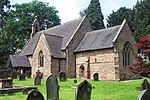Belvide Reservoir
Canal reservoirs in EnglandGrade II* listed buildings in StaffordshireNature reserves in StaffordshireReservoirs in StaffordshireShropshire Union Canal ... and 3 more
Sites of Special Scientific Interest in StaffordshireUse British English from January 2017Works of Thomas Telford

Belvide Reservoir is a reservoir in South Staffordshire, England. It was built in 1833 to supply the Birmingham and Liverpool Junction Canal, and has been managed as a nature reserve since 1977. It has been used to study the effect of water level changes on bird populations.
Excerpt from the Wikipedia article Belvide Reservoir (License: CC BY-SA 3.0, Authors, Images).Belvide Reservoir
Shutt Green Lane, South Staffordshire Brewood and Coven
Geographical coordinates (GPS) Address Nearby Places Show on map
Geographical coordinates (GPS)
| Latitude | Longitude |
|---|---|
| N 52.686 ° | E -2.193 ° |
Address
Shutt Green Lane
Shutt Green Lane
ST19 9LX South Staffordshire, Brewood and Coven
England, United Kingdom
Open on Google Maps









